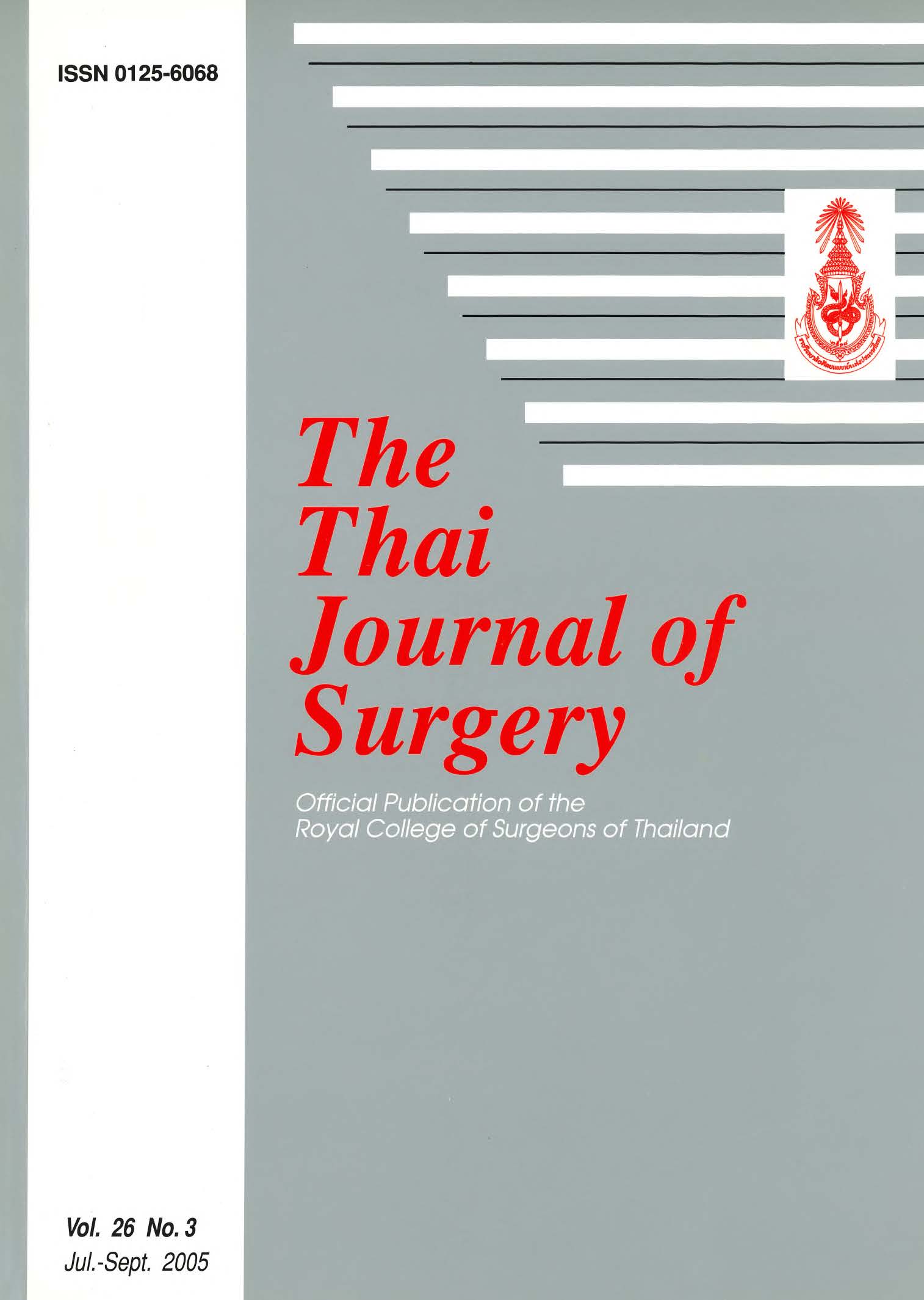Reliability of Detecting Macrometastases in Sentinel Lymph Node in Breast Cancer Patients by Bivalued Section in Comparison to Serial Section
Abstract
Objectives: The aim of this study was to compare the reliability of bivalved section with serial section to detect the macrometastases in sentinel lymph node in breast cancer patients.
Materials and Methods: A total number of 40 patients were involved in the reliability study to detect the macrometastases in sentinel lymph node (SLN) in breast cancer patients in the Department of Surgery, Phramongkutklao Hospital & College of Medicine, between January 2000 and June 2004.
Results: Of 76 sentinel lymph nodes, 28 were positive and 48 were negative. In detecting SLN by dye direct injection with isosulfan blue, 42 out of 45 cases were identified, with an identification rate of 93.3% and with false negative (skip metastases) in 2 cases (4.76%). The negative SLN by bivalved section was then studied by serial section at 1 mm interval and dyed with H & E, whereby I node of micrometastases was encountered. However, when compared with previous slide, the micrometastases already existed. No additional metastases were encountered in other lymph nodes as well as in false negative lymph nodes.
Conclusions: This study revealed that there was no difference in detecting macrometastases of SLN by bivalved section and serial section. The reliability in detecting the macrometastases by bivalved section in this study is 100%. However, the numbers of the sample are too small for conclusion and further studies with more sample size are required.
References
2. Teneja, Gardner B. Therapeutic value of axillary lymph node dissection for breast cancer. In: Kirby IB, Edward MC lll, editors. The breast. 2nd ed. WB Saunders; 1998. p. 943-61.
3. Veronesi U, Rilke F, Luine A, et al. Distribution of axillary node metastases by level of invasion. Cancer 1987:59: 682-7.
4. Noguchi M. Sentinel Lymph node biopsy and breast cancer. Br J Surg 2002; 89: 21-34.
5. Jakub JW, Diaz NM, et al. Completion axillary lymph node dissection minimizes the likelihood of false negatives for patients with invasive breast carcinoma and cytokeratin positive only sentinel lymph nodes. Am J Surg 2002; 84:302
6. Wong SL, Chao C, et al. The use of cytokeratin staining in sentinel lymph node biopsy for breast cancer. Am J Surg 2001;182: 330-4.
7. Reynolds C, Mick R, et al. Sentinel Lymph node biopsy with metastases: Can axillary dissection be avoided in some patients with breast cancer? J Clin Oncol 1999; 17: 1720-6.
8. Zgajnar J, Besic N, et al. Minimal risk of macrometastases in the non-sentinel lymph nodes in breast cancer patients with micrometastatic sentinel lymph nodes and preoperative ultrasonically uninvolved axillary lymph nodes. Eur J Cancer 2004;1-5.
9. Saidi RF, Dudrick Ps, Remine SG, Mittal VK. Non sentinel lymph node status after positive sentinel lymph node biopsy in early breast cancer. Am Surg 2004; 70: 101-5.
10. Bergkvist L, Frisell J, et al. Multicentre study of detection and false-negative rates in sentinel node biopsy for breast cancer. Br J Surg 2001; 88: 1644-8.
11. Nano MT, Kollias J, et al. Clinical impact of false-negative sentinel node biopsy in primary breast cancer. Br J Surg 2002;89:1430-4.
Downloads
Published
How to Cite
Issue
Section
License
Articles must be contributed solely to The Thai Journal of Surgery and when published become the property of the Royal College of Surgeons of Thailand. The Royal College of Surgeons of Thailand reserves copyright on all published materials and such materials may not be reproduced in any form without the written permission.



